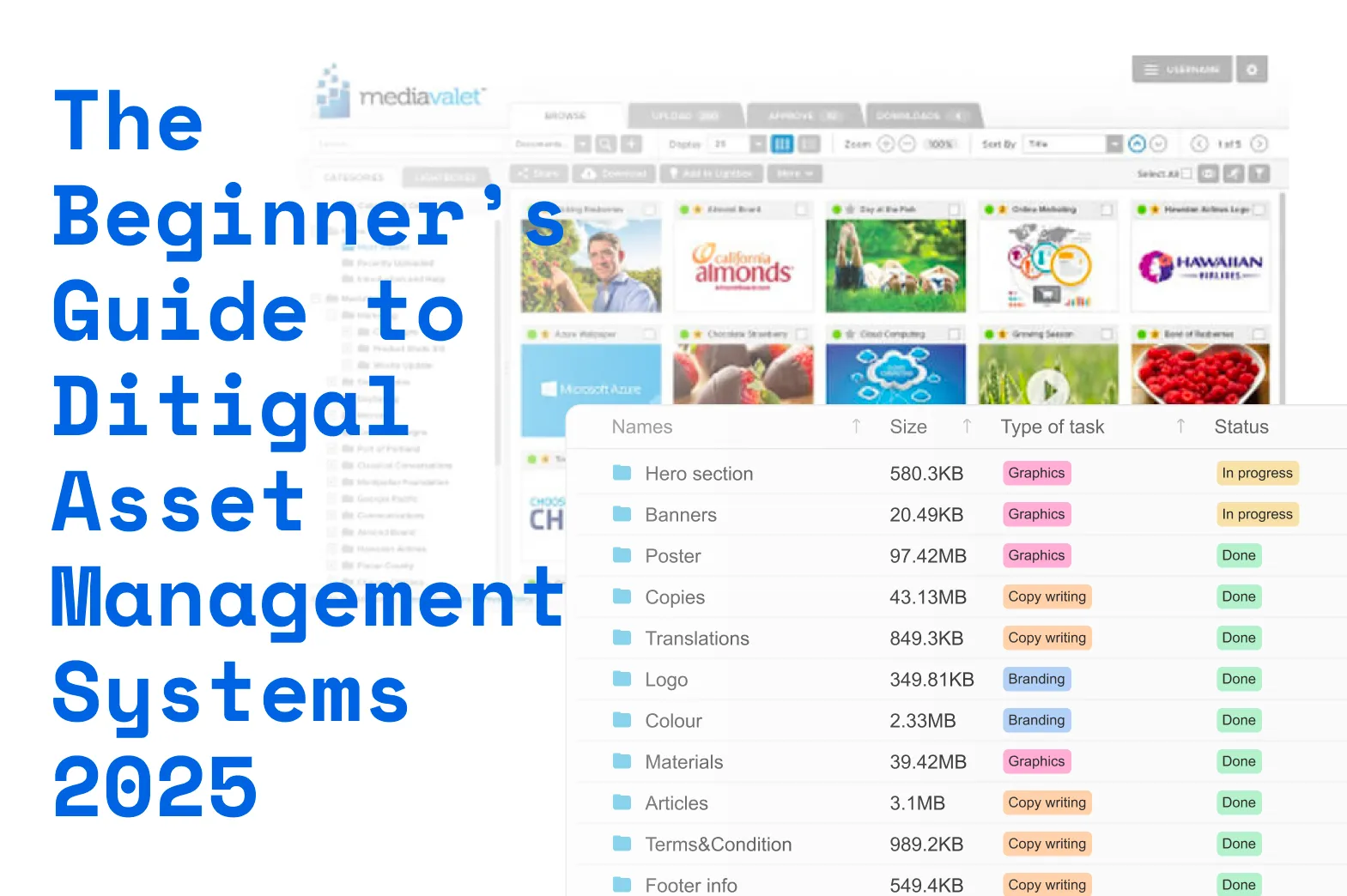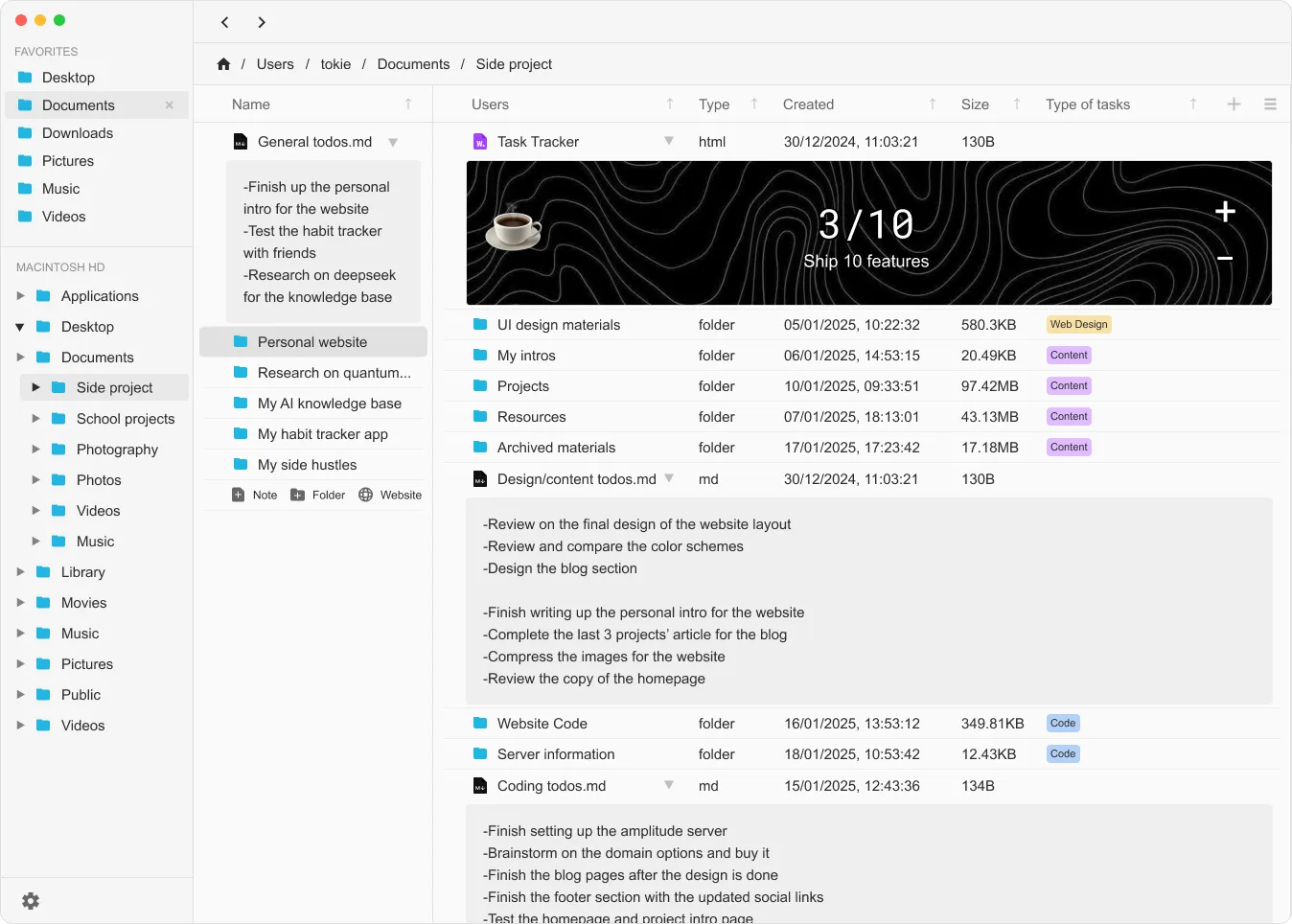The Beginner’s Guide to Digital Asset Management Systems(2025)

TL;DR
If your team spends more time hunting for files than using them, you've outgrown shared drives. A digital asset management system (DAM) centralises brand assets and adds searchable metadata. While enterprise DAMs offer comprehensive features, Tokie provides a lightweight, local-first alternative that gives small teams the essentials without the enterprise complexity.
1 Understanding Digital Asset Management Systems
A digital asset management system (DAM) is a purpose-built repository for storing, organising and distributing rich media—from product images to brand guidelines. Unlike generic cloud drives, traditional enterprise DAMs offer:
- Structured metadata (keywords, usage rights, campaign IDs)
- Roles & permissions for controlled access
- Visual previews for large files
- Automated workflows for approvals and distribution
- Integrations with creative tools and content systems
Quick stat: Creative teams lose 8.3 hours per week searching for "the right file" (Gartner, 2024). The right file management solution cuts that in half.
When teams outgrow shared drives, they typically face version chaos (final_v2_REAL_final.jpg), limited search capabilities, brand misuse, and security concerns. This is where digital asset management tools become essential.
2 Introducing Tokie: A Local-First Alternative
While enterprise digital asset management software offers comprehensive features, many teams need a simpler solution. Tokie takes a different approach:

2.1 What Tokie Is (And Isn't)
Tokie is a local-first file manager that brings select DAM principles to teams without the enterprise complexity:
| Feature | Enterprise DAM | Tokie |
|---|---|---|
| Central repository | Cloud-based, shared | Local-first with selective cloud sync |
| Metadata | Extensive custom fields | Smart tags, basic attributes |
| Permissions | Complex role hierarchies | Simple sharing controls |
| Workflows | Automated approval chains | Basic version tracking |
| Integrations | Enterprise ecosystem | Local files with less need to complex integration |
| Pricing model | Subscription/user | Perpetual license ("buy once, own forever") |
2.2 Tokie's Core Strengths
- Lightning-fast local browsing – No cloud latency when searching your assets
- Selective cloud sync – Share only what you need, maintain privacy for the rest
- Smart organization – Tags, collections, and visual previews without the complexity
- No vendor lock-in – Your files remain in your standard file system
- Affordable scaling – Fixed cost per user
You might want to read this 5 smart file organization tricks every Mac user should know in 2025 to see how Tokie can be used to better organise digital files.
"Tokie bridges the gap between chaotic shared folders and over-engineered enterprise DAMs. It's the Goldilocks solution for small to mid-sized creative teams."
3 Key Features of Modern Digital Asset Management
3.1 Essential DAM Capabilities
Whether you choose an enterprise solution or Tokie's streamlined approach, effective digital asset management workflow requires:
- Searchable assets – Find what you need when you need it
- Version control – Track changes and maintain a single source of truth
- Preview capabilities – Quickly review files without opening native applications
- Sharing mechanisms – Distribute assets securely to stakeholders
- Organization system – Structure that makes sense for your team
3.2 Where Tokie Fits In
Tokie focuses on delivering the core experience without the enterprise overhead:
- Smart tagging – Organize with flexible tags instead of rigid hierarchies
- Fast visual browsing – Preview-driven interface for quick asset location
- Lightweight sharing – Using existing cloud drive infrastructure for sharing files
- Local performance – No waiting for cloud servers to respond
4 Deployment Models & Choosing the Right Solution
| Model | Good for | Example |
|---|---|---|
| Enterprise cloud DAM | Large organizations, complex workflows | Adobe Experience Manager, Bynder |
| Mid-market SaaS DAM | Growing teams, moderate complexity | Canto, Brandfolder |
| On-prem / air-gapped | Regulated industries, security concerns | ResourceSpace, NetX |
| Local-first hybrid | Creative teams, performance priority | Tokie, PhotoPrism |
4.1 When to Choose Enterprise DAM
Enterprise digital asset management systems make sense when you need:
- Complex approval workflows with multiple stakeholders
- Extensive integration with marketing technology stack
- Global distribution with region-specific permissions
- Comprehensive rights management for licensed assets
- Advanced AI for auto-tagging and content analysis
4.2 When Tokie Is the Right Fit
Tokie works best for teams that:
- Value speed and simplicity over complex features
- Want to maintain control of their assets locally
- Need basic organization without enterprise overhead
- Prefer one-time purchase over ongoing subscriptions
- Don't require complex approval workflows
5 Getting Started: Implementation Guide
Whether implementing an enterprise DAM or Tokie, follow these steps:
- Audit existing assets – Know what you're working with
- Define organization system – Create a simple taxonomy
- Start small – Begin with a pilot project or department
- Import strategically – Don't migrate everything at once
- Train your team – Ensure adoption with proper onboarding
- Iterate and improve – Refine your system based on feedback
With Tokie, this process is significantly streamlined—you can be up and running in days rather than weeks or months required for enterprise DAM implementation.
6 Future-Proofing Your Asset Management
The future of digital asset management tools includes:
- AI-enhanced organization – Smarter tagging and content recognition
- Local-first architecture – Balancing performance and collaboration
- Simplified workflows – Less complexity, more productivity
- Open ecosystems – Better integration between tools
Tokie embraces these trends with its local-first approach, focusing on performance and simplicity while providing the essential capabilities teams need without enterprise bloat.
7 Conclusion
Digital asset chaos doesn't scale. While enterprise digital asset management systems offer comprehensive features, they often come with complexity and cost barriers for smaller teams.
Tokie provides a refreshing alternative—a local-first approach that delivers the core benefits of organized, searchable assets without the enterprise overhead. It's the right-sized solution for teams that have outgrown shared drives but don't need (or want) the complexity of enterprise DAM.
Ready to see it in action? Go to the bottom of the page and download tha app and experience how the right balance of features can transform your asset management without breaking your workflow or budget.
FAQ (People Also Ask)
What's the difference between DAM and MAM?
A DAM manages all digital files (images, docs, design files). A media asset management system (MAM) focuses on large, time-based media—video and broadcast workflows—with extras like proxy editing, frame-accurate markers and transcode farms.
Is open-source digital asset management viable for small teams?
Yes—projects like ResourceSpace and PhotoPrism are free to self-host. Factor in server costs and admin time; a low-cost SaaS or local-first tool like Tokie might be more cost-effective long-term.
How much storage do I need?
Rule of thumb: audit 12 months of content creation and triple it for growth plus versions. Most teams underestimate video's footprint—plan for proxy + master. Tokie's local-first approach lets you optimize by keeping frequently-used assets local and archiving others.
Can I integrate a DAM with my CMS?
Modern DAM APIs or out-of-the-box plugins let you drop media URLs directly into WordPress, Contentful or headless front-ends. Tokie offers simpler integration through direct file access and shareable cloud drives links.
How long does implementation take?
Enterprise DAM rollouts typically take 8–12 weeks for complex setups. With Tokie, most teams are up and running in hours, not days or weeks, thanks to its simplified approach and familiar file system foundation.
Ready to try Tokie?
Transform your file management experience with Tokie's powerful features.